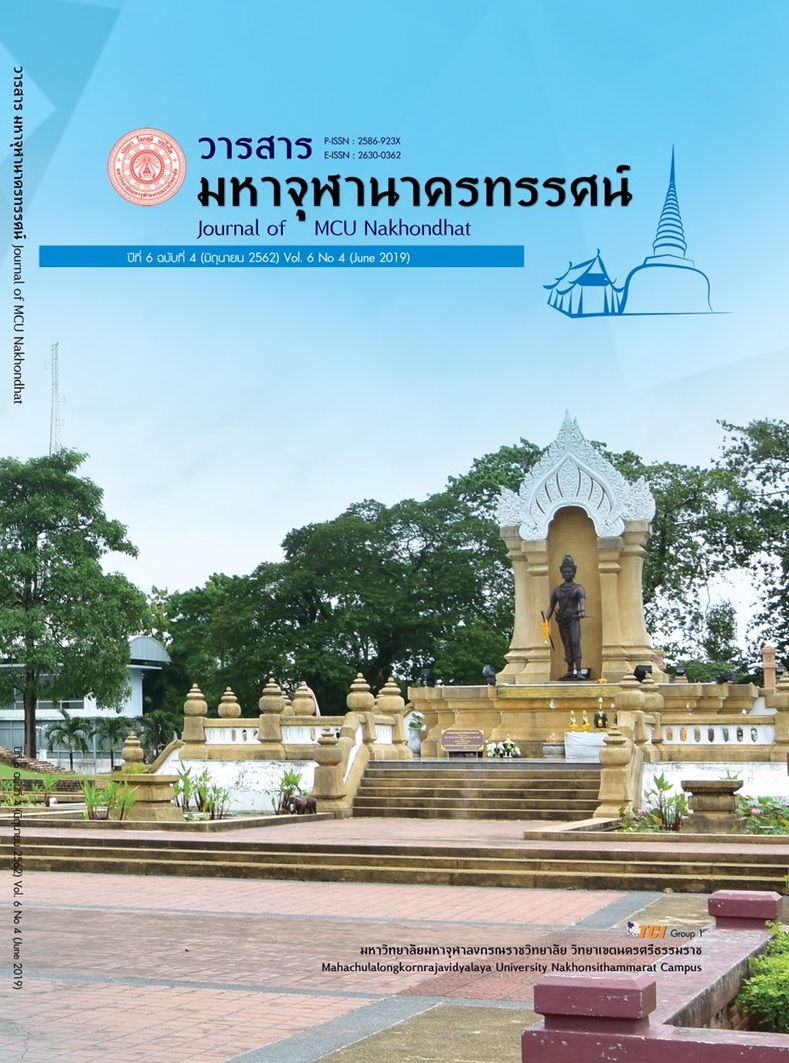THAI SANGHA AND SOCIAL MOVEMENTS: A CASE STUDY OF STUDY OF MOVEMENTS IN STSTING BUDDHIM AS THE NATIONAL RELIGION IN THE DRAFT OF THAI CONSTITUTION B.E. 2559
Main Article Content
Abstract
The objectives of the study the background and explain the roles of monks in the movement to push the Constitution Drafting Committee (C.D.C.) to enforce Buddhism as the national religion and to study and analyze the patterns and strategies of the monk movement in the issue to enforce Buddhism as the national religion using qualitative research to study.
The research found that:
the enforcement of issue of "Buddhism to be the national religion" occurred first during the amendment of constitution in 1994, the draft of Constitution B.E.2540, and the draft of Constitution B.E.2550, respectively. However, it was unsuccessful. The movement of the monk network occurred again when the Constitution was drafted in 2015 – 2016. There was the large gathering of monks under the name of "Hindering the plan of Thai monk administration" with the issue of enforcing Buddhism as the national religion to be the last demanded issue. Finally, the Constitution Drafting Committee was unable to fulfill the demand. However, the promotion of Theravada Buddhism was increased in Section 67 as never been before in any constitution. The movement of monk network used the form and strategy to raise the resources from online social media, especially Facebook and Line, as well as having the senior monk with prestige to "stimulate" and encourage the public to have awareness and join in the gathering by using the television and radio networks to distribute the news. Eventually, the mass of monks and people up to 30,000 persons could be gathered to participate in a large gathering on 15th February, 2016 at the front of Buddha Monthon, Nakhon Pathom Province. Moreover, the monk network also used the strategy to send the representatives of various Buddhist organizations to negotiate with the Constitution Drafting Committee for several times to put pressure to the Constitution Drafting Committee. After Buddhist monks and representatives of the various elements get together already, the meeting reviewed various organizational roles that drives Buddhism, and is filling the country with Thailand, a country where there are a large number of Buddhists.
Article Details
References
ธีระพล โชคนำชัย. (2555). ปัญหาการบัญญัติศาสนาประจำชาติในรัฐธรรมนูญ : ศึกษาเปรียบเทียบจากรัฐธรรมนูญของประเทศต่างๆ. ใน วิทยานิพนธ์นิติศาสตรมหาบัณฑิต สาขาวิชานิติศาสตร์. มหาวิทยาลัยธุรกิจบัณฑิตย์.
พระมหาศักดิ์ สีลเดโช. (2528). การเคลื่อนไหวของคณะยุวสงฆ์ รุ่นที่ 2 (พ.ศ.2516-2522). ปาจารยสาร, 12(4), 40-48.
พระมหาหรรษา ธมฺมหาโส. (2557). แนวโน้มบทบาทพระสงฆ์กับการเมืองไทยในสองทศวรรษหน้า. กรุงเทพมหานคร: จุฬาลงกรณ์มหาวิทยาลัย.
พระศรีปริยัติโมลี. (2546). บันทึกเหตุการณ์หน้ารัฐสภา 5-20 กันยายน 2545 : สงฆ์กับการเมือง Monks and Politics. กรุงเทพมหานคร: โรงพิมพ์มหาจุฬาลงกรณราชวิทยาลัย.
พระสมพงษ์ พูลสุข. (2553). บทบาทของพระสงฆ์ในการผลักดันให้มีการบัญญัติพระพุทธศาสนาเป็นศาสนาประจำชาติ พ.ศ. 2537 - พ.ศ. 2550. ใน วิทยานิพนธ์รัฐศาสตรมหาบัณฑิต สาขาวิชารัฐศาสตร์. มหาวิทยาลัยสุโขทัยธรรมาธิราช.
พิสิษฐ์ พลรักษ์เขตต์. (2559). ฟังแล้วช็อก? ศาสนาพุทธเป็นศาสนาประจำชาติอันตราย. เรียกใช้เมื่อ 30 มกราคม 2559 จาก https://www.dailynews.co.th/article /376241
McAdam, D. (1983). TactIcal Innovation and The Pace of Insurgency. American Sociological Review, 48(6), 735-754.


